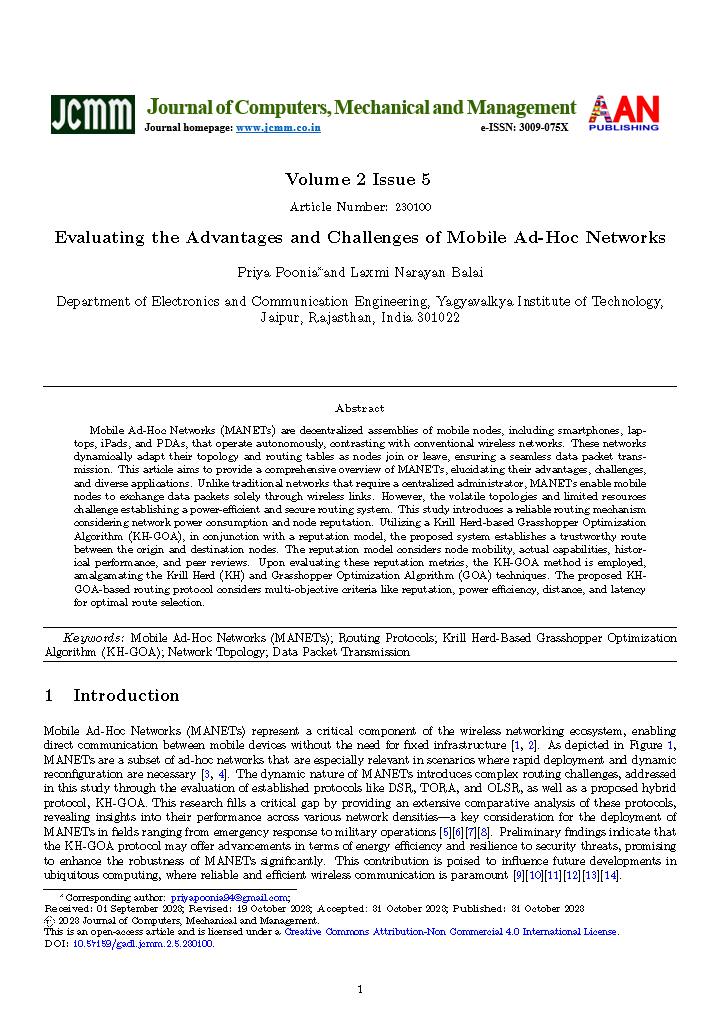Evaluating the Advantages and Challenges of Mobile Ad-Hoc Networks
DOI:
https://doi.org/10.57159/gadl.jcmm.2.5.230100Keywords:
Mobile Ad-Hoc Networks (MANETs), Routing Protocols, Krill Herd-based Grasshopper Optimization Algorithm (KH-GOA), Network Topology, Data Packet TransmissionAbstract
Mobile Ad-Hoc Networks (MANETs) are decentralized assemblies of mobile nodes, including smartphones, laptops, iPads, and PDAs, that operate autonomously, contrasting with conventional wireless networks. These networks dynamically adapt their topology and routing tables as nodes join or leave, ensuring a seamless data packet transmission. This article aims to provide a comprehensive overview of MANETs, elucidating their advantages, challenges, and diverse applications. Unlike traditional networks that require a centralized administrator, MANETs enable mobile nodes to exchange data packets solely through wireless links. However, the volatile topologies and limited resources challenge establishing a power-efficient and secure routing system. This study introduces a reliable routing mechanism considering network power consumption and node reputation. Utilizing a Krill Herd-based Grasshopper Optimization Algorithm (KH-GOA), in conjunction with a reputation model, the proposed system establishes a trustworthy route between the origin and destination nodes. The reputation model considers node mobility, actual capabilities, historical performance, and peer reviews. Upon evaluating these reputation metrics, the KH-GOA method is employed, amalgamating the Krill Herd (KH) and Grasshopper Optimization Algorithm (GOA) techniques. The proposed KH-GOA-based routing protocol considers multi-objective criteria like reputation, power efficiency, distance, and latency for optimal route selection.
References
M. A. Al-Absi, A. A. Al-Absi, M. Sain, and H. Lee, “Moving ad hoc networks—a comparative study,” Sustainability, vol. 13, no. 11, p. 6187, 2021.
S. Basagni, M. Conti, S. Giordano, and I. Stojmenovic, eds., Mobile ad hoc networking: cutting edge directions. John Wiley & Sons, 2013.
R. Ramdhany, P. Grace, G. Coulson, and D. Hutchison, “Manetkit: supporting the dynamic deployment and reconfiguration of ad-hoc routing protocols,” in Middleware 2009: ACM/IFIP/USENIX, 10th International Middleware Conference, vol. 10, Urbana, IL, USA, pp. 1–20, Springer Berlin Heidelberg, 2009.
I. Chlamtac, M. Conti, and J. J.-N. Liu, “Mobile ad hoc networking: imperatives and challenges,” Ad hoc networks, vol. 1, no. 1, pp. 13–64, 2003.
L. Raja and S. Santhosh Baboo, “An overview of manet: Applications, attacks and challenges,” International Journal of Computer Science and Mobile Computing, vol. 3, no. 1, pp. 408–417, 2014.
M. Chitkara and M. W. Ahmad, “Review on manet: characteristics, challenges, imperatives and routing protocols,” International Journal of Computer Science and Mobile Computing, vol. 3, no. 2, pp. 432–437, 2014.
S. Mohammad, M. Alsanabani, and T. Alahdal, “Comparison study of routing protocols in manet,” International Journal of Ad Hoc, Vehicular and Sensor Networks, vol. 1, no. 1, pp. 1–9, 2014.
A. Odeh, E. AbdelFattah, and M. Alshowkan, “Performance evaluation of aodv and dsr routing protocols in manet networks,” International Journal of Distributed and Parallel Systems, vol. 3, no. 4, p. 13, 2012.
S. M. Badhusha and K. Duraiswamy, “Energy efficient improved bandwidth video streaming through reliable multipath propagation in manets,” International Journal of Applied Engineering Research, vol. 10, no. 13, 2015.
G. S. Mamatha and D. S. Sharma, “Analyzing the manet variations, challenges, capacity and protocol issues,” International Journal of Computer Science & Engineering Survey (IJCSES), vol. 1, no. 1, pp. 14–21, 2010.
P. Goyal, V. Parmar, and R. Rishi, “Manet: vulnerabilities, challenges, attacks, application,” IJCEM International Journal of Computational Engineering & Management, vol. [volume missing], no. 2011, pp. 32–37, 2011.
M. U. Aftab, A. Nisar, D. Asif, A. Ashraf, and B. Gill, “Rbac architecture design issues in institutions collaborative environment,” arXiv preprint arXiv:1310.5962, 2013.
M. U. Aftab, M. A. Habib, N. Mehmood, M. Aslam, and M. Irfan, “Attributed role based access control model,” in 2015 Conference on Information Assurance and Cyber Security (CIACS), pp. 83–89, IEEE, 2015.
R. Agrawal, N. Faujdar, C. A. T. Romero, O. Sharma, G. M. Abdulsahib, O. I. Khalaf, R. F. Mansoor, and O. A. Ghoneim, “Classification and comparison of ad hoc networks: A review,” Egyptian Informatics Journal, 2022.
Y. Cheng, E. K. Cetinkaya, and J. P. Sterbenz, “Dynamic source routing (dsr) protocol implementation in ns-3,” in Proceedings of the 5th international ICST conference on simulation tools and techniques, pp. 367–374, 2012.
S. A. Almazok and B. Bilgehan, “A novel dynamic source routing (dsr) protocol based on minimum execution time scheduling and moth flame optimization (met-mfo),” EURASIP Journal on Wireless Communications and Networking, vol. 2020, pp. 1–26, 2020.
V. D. Park and M. S. Corson, “A performance comparison of the temporally-ordered routing algorithm and ideal linkstate routing,” in Proceedings Third IEEE Symposium on Computers and Communications. ISCC’98, pp. 592–598, IEEE, 1998.
T. Clausen and P. Jacquet, “Optimized link state routing protocol (olsr),” RFC RFC 3626, RFC Editor, 2003.

Downloads
Published
How to Cite
Issue
Section
License
Copyright (c) 2023 Journal of Computers, Mechanical and Management

This work is licensed under a Creative Commons Attribution-NonCommercial 4.0 International License.
The Journal of Computers, Mechanical and Management applies the CC Attribution- Non-Commercial 4.0 International License to its published articles. While retaining copyright ownership of the content, the journal permits activities such as downloading, reusing, reprinting, modifying, distributing, and copying of the articles, as long as the original authors and source are appropriately cited. Proper attribution is ensured by citing the original publication.





